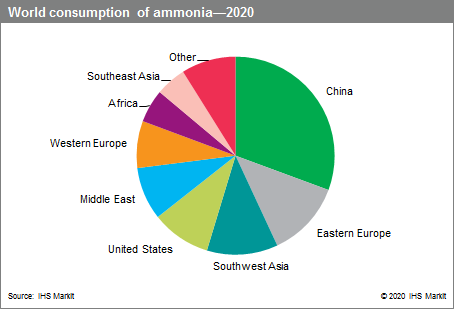دانلود گزارش Ammonia از CEH سال 2020

خرید گزارش Ammonia
برای دانلود فایل Ammonia مربوط به Chemical Economics Handbook و دریافت پی دی اف بررسی اجمالی صنعت پتروشیمی بر روی کلید خرید در انتهای صفحه کلیک کنید. پس از اتصال به درگاه پرداخت و تکمیل مراحل خرید، لینک دانلود ایمیل می شود. این گزارش مربوط به سال 2020 و در فرمت PDF ارسال می شود.
در صورتی که نیاز به دانلود هر گزارشی از IHS و یا PEP دارید، فقط کافیست ادرس اینترنتی گزارش را از سایت ihsmarkit.com و یا https://global.ihs.com برای ما ارسال کنید (راههای ارتباطی در صفحه تماس با گیگاپیپر ). پس از بررسی، هزینه ان اعلام می شود. پس از واریز نسخه الکترونیکی ارسال می شود.

Ammonia
Chemical Economics Handbook
Published July 2020
For Download Please Contact Us :
Price : 55$
دانلود رایگان گزارش Ammonia
برای اطمینان از کیفیت گزارش Ammonia ، چند صفحه ابتدایی ان بصورت رایگان قرار داده شده است.گزارشهای دیگر دانلودی از ihsmarkit.com به همین صورت هستند.
درباره گزارش Ammonia
Ammonia is the basic building block of the world nitrogen industry; consumption of ammonia for nitrogen fertilizers account for more than 80% of the world ammonia market. Nitrogen fertilizers are the most widely used fertilizers in the world, accounting for close to 60% of all fertilizers. With the exception of China, where much of the ammonia is produced from coal gasification, most of the world’s ammonia is produced from natural gas.
The following pie chart shows world consumption of ammonia:
Ammonia is processed into downstream fertilizer products before being applied to the soil. These products include urea, ammonium nitrates, ammonium sulfate, ammonium phosphates, and nitrogen solutions. Consumption of ammonia in industrial applications is projected to grow slightly faster than fertilizer use during the forecast period. Ammonia is used to produce ammonium nitrates that are used to make explosives (covered in the CEH Explosives and Blasting Agents report). It is also used in the production of acrylonitrile for acrylic fibers and plastics, hexamethylenediamine for nylon 66, caprolactam for nylon 6, isocyanates for polyurethanes and hydrazine, and various amines and nitriles.
The global ammonia market had been steady in the recent past until the start of the COVID-19 crisis. There were minimal constraints associated with feedstock natural gas availability in key producing regions. Mainland China experienced a sharp increase in coal prices and faced steeper competition in its urea export market resulting in a drastic decline in ammonia production from 2016 to 2018. However, production increased in 2019 in the Middle East and the United States, with only a minor loss in total global production.
The world has been experiencing weaker nutrient demand in recent years because of poor economic prospects, lower crop and food prices, increasing competition, and fluctuating energy prices. A reduction in fertilizer prices has had a significant impact on fertilizer producers’ earning potential. Although there have been capacity curtailments, consolidation announcements, and cost-cutting measures, fertilizer production and import levels have remained healthy. Because of COVID-19, the demand for ammonia fell drastically in 2020. It was caused by a decrease in the demand for industrial consumers while the agricultural sector experienced a smaller decline, mostly because of logistics and financial issues.
The shares of feedstocks such as naphtha and fuel oil are declining; natural gas is the preferred raw material for newer ammonia plants. During the forecast period, the share of natural gas is expected to increase. However, ammonia plants are expensive; investment costs can exceed $1 billion and plants can take up to three years to build.
During 2020–25, world apparent consumption of ammonia is forecast to increase by about 12.9%. The global ammonia supply/demand balance is expected to move toward a surplus, as future capacity additions will continue to outpace consumption. Ammonia capacity is increasing primarily in areas where the availability and cost of natural gas are lower, in particular, the United States and the Middle East.
For more detailed information, see the table of contents, shown below.
IHS Markit’s Chemical Economics Handbook –Ammonia is the comprehensive and trusted guide for anyone seeking information on this industry. This latest report details global and regional information, including
دانلود گزارش بررسی اجمالی صنعت پتروشیمی
آمونیاک عنصر اصلی صنعت نیتروژن در جهان است. مصرف آمونیاک برای کودهای ازته بیش از 80٪ بازار جهانی آمونیاک را تشکیل می دهد. کودهای نیتروژن پرکاربردترین کودها در جهان هستند که نزدیک به 60٪ از کل کودها را تشکیل می دهند. به استثنای چین که بیشتر آمونیاک از گازرسانی ذغال تولید می شود ، بیشتر آمونیاک جهان از گاز طبیعی تولید می شود.
نمودار پای زیر مصرف جهانی آمونیاک را نشان می دهد:
آمونیاک قبل از استفاده به خاک ، به محصولات کود پایین دست تبدیل می شود. این محصولات شامل اوره ، نیترات آمونیوم ، سولفات آمونیوم ، فسفات آمونیوم و محلول های نیتروژن است. پیش بینی می شود که مصرف آمونیاک در مصارف صنعتی کمی سریعتر از مصرف کود در دوره پیش بینی رشد کند. از آمونیاک برای تولید نیتراتهای آمونیوم استفاده می شود که برای ساخت مواد منفجره استفاده می شود (در گزارش CEH Explosives and Blasting Agents). این ماده همچنین در تولید اکریلونیتریل برای الیاف و پلاستیک های اکریلیک ، هگزامتیلن دی آمین برای نایلون 66 ، کاپرولاکتام برای نایلون 6 ، ایزوسیانات ها برای پلی اورتان ها و هیدرازین و انواع آمین ها و نیتریل ها استفاده می شود.
بازار جهانی آمونیاک در گذشته نزدیک تا آغاز بحران COVID-19 ثابت بوده است. حداقل محدودیت های مربوط به در دسترس بودن گاز طبیعی مواد اولیه در مناطق اصلی تولید وجود دارد. سرزمین اصلی چین افزایش چشمگیری در قیمت ذغال سنگ تجربه کرد و در بازار صادرات اوره با رقابت شدیدتری روبرو شد که منجر به کاهش شدید تولید آمونیاک از سال 2016 به 2018 شد. با این حال ، تولید در سال 2019 در خاورمیانه و ایالات متحده افزایش یافت ، فقط یک جزئی ضرر در کل تولید جهانی.
به دلیل چشم انداز اقتصادی ضعیف ، پایین آمدن قیمت محصولات و مواد غذایی ، افزایش رقابت و نوسان قیمت های انرژی در جهان ، تقاضای مواد مغذی ضعیف تری در سال های اخیر تجربه شده است. کاهش قیمت کود تأثیر مهمی بر درآمد تولیدکنندگان کود دارد. اگرچه محدودیت ظرفیت ، اعلامیه های تلفیق و اقدامات کاهش هزینه وجود داشته است ، اما میزان تولید و واردات کود همچنان سالم مانده است. به دلیل COVID-19 ، تقاضا برای آمونیاک به شدت در سال 2020 کاهش یافت. این امر به دلیل کاهش تقاضا برای مصرف کنندگان صنعتی ایجاد شد ، در حالی که بخش کشاورزی کاهش کمتری را تجربه کرد ، بیشتر به دلیل مسائل لجستیکی و مالی.
سهام مواد خوراکی مانند نفتا و مازوت در حال کاهش است. گاز طبیعی ماده اولیه ترجیحی برای گیاهان جدید آمونیاک است. طی دوره پیش بینی ، انتظار می رود سهم گاز طبیعی افزایش یابد. با این حال ، گیاهان آمونیاک گران هستند. هزینه های سرمایه گذاری می تواند بیش از 1 میلیارد دلار باشد و ساخت کارخانه تا سه سال طول می کشد.
طی 25-20-2020 ، پیش بینی می شود که میزان مصرف آمونیاک در جهان حدود 12.9 درصد افزایش یابد. انتظار می رود تعادل عرضه و تقاضای آمونیاک جهانی به سمت مازاد حرکت کند ، زیرا ظرفیت های آینده در مصرف محصولات پیشی می گیرند. ظرفیت آمونیاک در درجه اول در مناطقی که میزان دسترسی و هزینه گاز طبیعی پایین تر است ، به ویژه ایالات متحده و خاورمیانه در حال افزایش است.
برای اطلاعات بیشتر ، به فهرست مطالب مراجعه شده در زیر مراجعه کنید.
IHS Markit’s Chemical Economy Handbook –Ammonia راهنمای جامع و قابل اعتماد برای هر کسی است که به دنبال اطلاعاتی در مورد این صنعت است. این آخرین گزارش جزئیات اطلاعات جهانی و منطقه ای ، از جمله
Download Ammonia
Contents
Executive summary7
Summary9
World supply and demand11
Capacity12
Production14
Consumption15
Price18
Trade20
Introduction22
Manufacturing processes24
Synthesis gas production24
Steam reforming24
Partial oxidation24
Cryogenic separation25
Coal gasification25
Electrolysis25
Synthesis gas purification25
Shift conversion25
Removal of carbon dioxide26
Removal of residual carbon monoxide and carbon dioxide26
Ammonia synthesis26
Trends in synthetic ammonia plant development26
Ammonia plant retrofits27
Trends in costs27
Recovered ammonia28
Coking by-product28
Petroleum refinery wastewater29
Green ammonia29
Other developments29
Ammonia as an energy carrier30
Environmental issues31
Supply and demand by region32
United States32
Producing companies32
Salient statistics37
Consumption38
Direct application as fertilizer41
Downstream products42
Chemical uses42
Caprolactam42
Acrylonitrile42
Hydrogen cyanide42
Miscellaneous amines and nitriles42
Other43
Industrial-grade ammonia43
Distribution43
Price44
Trade46
Canada48
Producing companies48
Salient statistics49
Consumption49
Price50
Trade51
Mexico51
Producing companies51
Salient statistics52
Consumption53
Central and South America54
Producing companies54
Salient statistics58
Production59
Consumption59
Trade61
Western Europe62
Producing companies62
Capacity64
Salient statistics65
Production66
Consumption67
Trade69
Central Europe71
Producing companies71
Capacity73
Salient statistics74
Production75
Consumption76
Trade78
Eastern Europe79
Producing companies79
Capacity83
Salient statistics84
Production84
Consumption85
Trade86
Middle East87
Producing companies87
Capacity90
Salient statistics91
Production92
Consumption93
Trade95
Africa96
Producing companies96
Capacity99
Salient statistics100
Production100
Consumption101
Trade103
Southwest Asia104
Producing companies104
Salient statistics108
Production109
Consumption109
Trade111
China111
Producing companies111
Salient statistics120
Consumption121
Urea122
Nitric acid122
Ammonium nitrate123
Ammonium phosphates123
Ammonium sulfate123
Ammonium chloride123
Ammonium bicarbonate123
Acrylonitrile124
Caprolactam124
Alkylamines124
Other124
Price124
Trade124
Japan125
Producing companies125
Salient statistics126
Consumption127
Trade128
Other Northeast Asia129
Producing companies129
Salient statistics129
Consumption130
Trade131
Southeast Asia132
Producing companies132
Salient statistics134
Production135
Consumption135
Trade137
Oceania138
Producing companies138
Salient statistics138
Production139
Consumption140
Trade141
Additional resources142
Revisions143